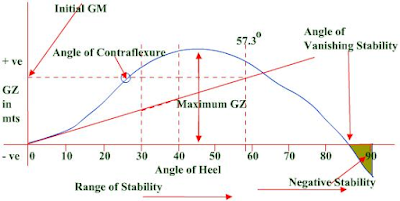IMO Intact stability Criterions
For a cargo vessel, the intact stability requirements are follows-
1. Initial GM or metacentric height should not be less then 0.15 m.
2. Righting lever GZ should be at least 0.2 m and angle of heel Ѳ ≥ 30̊.
3. Maximum righting lever should occur at heel >30̊ preferably but not less than 25̊.
4. The Area of the GZ curve should be at least:
a. 0.055 m radian up to Ѳ = 30̊
b. 0.090 m radian up to Ѳ = 40̊
c. 0.03 m radian between 30̊ and 40̊ or between 30̊ and angle of down flooding.
The angle of down flooding is an angle at which deck immersion takes place with subsequent water ingress.
Curve Of Statical Stability
Initial metacentric height – point of intersection of the tangent drawn to the curve at the initial point and a vertical through the angle of heel of 57.3° (1 radian).
Angle of contraflexure – the angle of heel up to which the rate of increase of GZ with heel is increasing. Though the GZ may increase further, the rate of increase of GZ begins to decrease at this angle.
The range of stability – where all GZ values are positive.
The maximum GZ lever & the angle at which it occurs.
The angle of vanishing stability – beyond which the vessel will capsize.
The area of negative stability.
The moment of statical stability at any given angle of heel (GZ x Displacement of the ship).
The moment of dynamical stability – work done in heeling the ship to a particular angle.
Dynamical stability at è = W x A (in t-m-rad)
W = Displacement (in tonnes)
A = area between the curve and the baseline up to the given angle of heel (in metre-radians).
1. Initial GM or metacentric height should not be less then 0.15 m.
2. Righting lever GZ should be at least 0.2 m and angle of heel Ѳ ≥ 30̊.
3. Maximum righting lever should occur at heel >30̊ preferably but not less than 25̊.
4. The Area of the GZ curve should be at least:
a. 0.055 m radian up to Ѳ = 30̊
b. 0.090 m radian up to Ѳ = 40̊
c. 0.03 m radian between 30̊ and 40̊ or between 30̊ and angle of down flooding.
The angle of down flooding is an angle at which deck immersion takes place with subsequent water ingress.
Curve Of Statical Stability
- Graph where GZ is plotted against the angle of heel.
- Drawn for each voyage condition by the ship’s officer.
- This curve is for a particular displacement and KG.
Initial metacentric height – point of intersection of the tangent drawn to the curve at the initial point and a vertical through the angle of heel of 57.3° (1 radian).
Angle of contraflexure – the angle of heel up to which the rate of increase of GZ with heel is increasing. Though the GZ may increase further, the rate of increase of GZ begins to decrease at this angle.
The range of stability – where all GZ values are positive.
The maximum GZ lever & the angle at which it occurs.
The angle of vanishing stability – beyond which the vessel will capsize.
The area of negative stability.
The moment of statical stability at any given angle of heel (GZ x Displacement of the ship).
The moment of dynamical stability – work done in heeling the ship to a particular angle.
Dynamical stability at è = W x A (in t-m-rad)
W = Displacement (in tonnes)
A = area between the curve and the baseline up to the given angle of heel (in metre-radians).
KN Cross Curves of Stability
Same as the GZ cross curves and also used to get the GZ values for making the curve of statical stability.
The only difference being that here the KG is assumed to be ZERO.
This solves the problem of a sometimes positive and sometimes negative correction, as now the correction is always subtracted.
GZ = KN – KG Sine θ
Same as the GZ cross curves and also used to get the GZ values for making the curve of statical stability.
The only difference being that here the KG is assumed to be ZERO.
This solves the problem of a sometimes positive and sometimes negative correction, as now the correction is always subtracted.
GZ = KN – KG Sine θ
Damage Stability
A damage stability criterion varies from ship to ship and the requirement for the same is given in SOLAS chapter II-1. It may be single compartment flooding, multi compartment flooding, engine room flooding etc.
- Under all the criteria as applicable, vessel margin line should not be submerged after the damage. Margin line is an imaginary line drawn 75mm below the free board deck.
- Intact and damage stability are very important factors that govern the overall stability of the ship.

